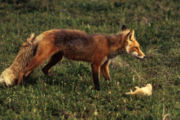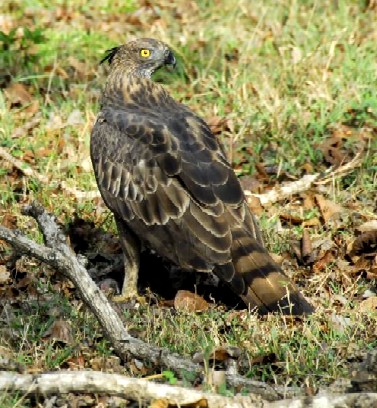Navigation
Rat Control in China Using Foxes and Eagles
Foxes, wolves and eagles have been deployed in the northern part of the Xinjiang Uygur Autonomous Region in Northwest China to help contain an outbreak of plains rats.
 |
| Red Fox, Vulpes vulpes with prey Photo: Wikipedia |
Foxes, wolves and eagles have been deployed in the northern part of the Xinjiang Uygur Autonomous Region in Northwest China to help contain an outbreak of plains rats.
Grazing land in parts of Xinjiang province has been overwhelmed by rats and other rodents which eat grass and gnaw tree roots intensifying desertification and diminishing food for sheep.
| Wikipedia |
"Because of the warm weather last winter, plains rats had a chance to breed in large numbers in northern Xinjiang Uygur Autonomous Region. The situation is threatening some 2 million hectares of grassland," said Shayila Wu, an official at the autonomous region's department of animal husbandry.
About 400,000 hectares, 30 percent, of grasslands in Fuyun and Qinghe, two counties in the Altai region, have already been overrun by plains rats, threatening the livelihoods of local people and causing great damage to the environment, he added. Several dozen herdsmen have been displaced.
 |
| Red fox (V. v. schrencki) lying in snow in Hokkaidô, Japan Photo: Wikipedia |
About 225 captive-bred foxes have been released to the wild in Ningxia Hui and Inner Mongolia autonomous regions and Shaanxi Province over the past four years to curb the fast reproduction of the rodents which eat grass and gnaw tree roots, according to China Daily.
Trainers feed rats to young foxes in captivity to improve their hunting techniques. As they grow, they are taken to pastureland regularly to adapt to the natural environment. They also mastered the skills to burrow and some silver-black foxes freed from 2003 to 2005 have mated with wild red foxes.
 |
| Red Fox, Vulpes vulpes, sitting |
Foxes are ideal rat-catchers, and are cheaper than poisons, which the rats can adapt to and which endanger other animals, said Li Kechang, deputy director of Grassland Division of the Ningxia Agriculture and Animal Husbandry Department. The foxes have been doing well in the wild, reducing the number of rats by up to 95.7 percent in a mountainous region of Haiyuan County in Ningxia between 2003 and 2004, said Li.
Xinjiang Uygur Autonomous Region's department of animal husbandry has also been relying on eagles, and wolves to help solve the rat problem.
 |
| Hawk Eagle The Mountain Hawk-eagle or Hodgson's Hawk-eagle (Spizaetus nipalensis) is a bird of prey. Like all eagles, it is in the family Accipitridae. It breeds in southern Asia from India and Sri Lanka to China and Japan.Photo:Wikipedia |
The local army has set up 50 perches for eagles. An eagle can eat about 10 rats a day on average.
Many of the rats are Lagurus luteus, which are known for their large bodies. An adult female can give birth to three to 12 rats per litter.
The pests eat grass roots and dig holes in the grassland. Local people fear the damages wrought by the rats, which not only destroy the grassland, but also spread diseases.
Other provinces, including Gansu and Qinghai, were also using the approach to eradicate rats, which were threatening more than 100 million hectares of sapling forests across the country, said You Dekang, the State Forestry Administration's head of plant diseases and insect control.
In addition, experts in Ningxia's Guyuan City have started to "recruit" weasels in the "ratcatcher force" this year.
Rats have thrived in Northwest China, partly due to global warming, some experts said. Efforts to develop farmland to grassland and forests also provide favorable living conditions for them. However, their natural enemies, such as foxes and weasels, are gradually disappearing due to human activities.
"It is hard to monitor foxes' activities and the number of rats, so we are deploying weasels, who also prey on rats, to ensure the effect," said An Yongping, an official with the county's forestry bureau.
“Workers had captured young wild weasels and were trying to breed them. They would go to the worst-plagued areas to restore the ecological balance,” said An.
The far western region of Xinjiang Uygur Autonomous Region is preparing to raise starlings in artificial nests to create an "air force" of birds to catch locusts, which destroy more than three million hectares of pasture every year.
Local officials believe that using starlings is the best biological means to control locusts, as previous means, such as chickens, had proved inadequate and spraying pesticide had contaminated pasture lands, home to millions of herdsmen.
Sources:
The Red Fox, Vulpes vulpes, is a mammal of the order Carnivora. It has the widest range of any terrestrial carnivore, being native to Canada, Alaska, almost all of the contiguous United States, Europe, North Africa and almost all of Asia, including Japan. It was introduced in Australia in the 19th century. As its name suggests, its fur is predominantly reddish-brown, but there is a naturally occurring grey morph known as the Silver Fox; a strain of tame Silver Fox has been produced from these animals by systematic domestication.
Source: Wikipedia
Eagles are large birds of prey which inhabit mainly the Old World, with only two species (the Bald Eagle and Golden Eagle) found in North America north of Mexico, a few in Middle and South America, two (the White-bellied Sea Eagle and Wedge-tailed Eagle) in Australia, and the Philippine Eagle in the Philippines. They are members of the bird order Falconiformes (or Accipitriformes, according to alternative classification schemes), family Accipitridae, and belong to several genera which are not necessarily closely related to each other in any sort of way.
Source: Wikipedia
Search
Latest articles
Agriculture
- World Water Week: Healthy ecosystems essential to human health: from coronavirus to malnutrition Online session Wednesday 24 August 17:00-18:20
- World Water Week: Healthy ecosystems essential to human health: from coronavirus to malnutrition Online session Wednesday 24 August 17:00-18:20
Air Pollution
- "Water and Sanitation-Related Diseases and the Changing Environment: Challenges, Interventions, and Preventive Measures" Volume 2 Is Now Available
- Global Innovation Exchange Co-Created by Horizon International, USAID, Bill and Melinda Gates Foundation and Others
Biodiversity
- It is time for international mobilization against climate change
- World Water Week: Healthy ecosystems essential to human health: from coronavirus to malnutrition Online session Wednesday 24 August 17:00-18:20
Desertification
- World Water Week: Healthy ecosystems essential to human health: from coronavirus to malnutrition Online session Wednesday 24 August 17:00-18:20
- UN Food Systems Summit Receives Over 1,200 Ideas to Help Meet Sustainable Development Goals
Endangered Species
- Mangrove Action Project Collaborates to Restore and Preserve Mangrove Ecosystems
- Coral Research in Palau offers a “Glimmer of Hope”
Energy
- Global Innovation Exchange Co-Created by Horizon International, USAID, Bill and Melinda Gates Foundation and Others
- Wildlife Preservation in Southeast Nova Scotia
Exhibits
- Global Innovation Exchange Co-Created by Horizon International, USAID, Bill and Melinda Gates Foundation and Others
- Coral Reefs
Forests
- NASA Satellites Reveal Major Shifts in Global Freshwater Updated June 2020
- Global Innovation Exchange Co-Created by Horizon International, USAID, Bill and Melinda Gates Foundation and Others
Global Climate Change
- It is time for international mobilization against climate change
- It is time for international mobilization against climate change
Global Health
- World Water Week: Healthy ecosystems essential to human health: from coronavirus to malnutrition Online session Wednesday 24 August 17:00-18:20
- More than 400 schoolgirls, family and teachers rescued from Afghanistan by small coalition
Industry
- "Water and Sanitation-Related Diseases and the Changing Environment: Challenges, Interventions, and Preventive Measures" Volume 2 Is Now Available
- Global Innovation Exchange Co-Created by Horizon International, USAID, Bill and Melinda Gates Foundation and Others
Natural Disaster Relief
- STOP ATTACKS ON HEALTH CARE IN UKRAINE
- Global Innovation Exchange Co-Created by Horizon International, USAID, Bill and Melinda Gates Foundation and Others
News and Special Reports
- World Water Week: Healthy ecosystems essential to human health: from coronavirus to malnutrition Online session Wednesday 24 August 17:00-18:20
- STOP ATTACKS ON HEALTH CARE IN UKRAINE
Oceans, Coral Reefs
- World Water Week: Healthy ecosystems essential to human health: from coronavirus to malnutrition Online session Wednesday 24 August 17:00-18:20
- Mangrove Action Project Collaborates to Restore and Preserve Mangrove Ecosystems
Pollution
- Zakaria Ouedraogo of Burkina Faso Produces Film “Nzoue Fiyen: Water Not Drinkable”
- "Water and Sanitation-Related Diseases and the Changing Environment: Challenges, Interventions, and Preventive Measures" Volume 2 Is Now Available
Population
- "Water and Sanitation-Related Diseases and the Changing Environment: Challenges, Interventions, and Preventive Measures" Volume 2 Is Now Available
- "Water and Sanitation-Related Diseases and the Changing Environment: Challenges, Interventions, and Preventive Measures" Volume 2 Is Now Available
Public Health
- Honouring the visionary behind India’s sanitation revolution
- Honouring the visionary behind India’s sanitation revolution
Rivers
- World Water Week: Healthy ecosystems essential to human health: from coronavirus to malnutrition Online session Wednesday 24 August 17:00-18:20
- Mangrove Action Project Collaborates to Restore and Preserve Mangrove Ecosystems
Sanitation
- Honouring the visionary behind India’s sanitation revolution
- Honouring the visionary behind India’s sanitation revolution
Toxic Chemicals
- "Water and Sanitation-Related Diseases and the Changing Environment: Challenges, Interventions, and Preventive Measures" Volume 2 Is Now Available
- Actions to Prevent Polluted Drinking Water in the United States
Transportation
- "Water and Sanitation-Related Diseases and the Changing Environment: Challenges, Interventions, and Preventive Measures" Volume 2 Is Now Available
- Urbanization Provides Opportunities for Transition to a Green Economy, Says New Report
Waste Management
- Honouring the visionary behind India’s sanitation revolution
- Honouring the visionary behind India’s sanitation revolution
Water
- Honouring the visionary behind India’s sanitation revolution
- Honouring the visionary behind India’s sanitation revolution
Water and Sanitation
- Honouring the visionary behind India’s sanitation revolution
- Honouring the visionary behind India’s sanitation revolution

